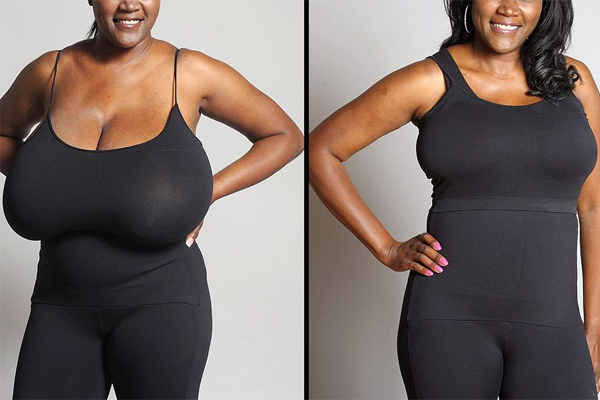Breast Reduction
Big breasts have been considered a sign of femininity and sexuality however overtly larger breasts can be abnormal and uncomfortable.
BREAST REDUCTION -REDUCE THE BREAST BURDEN, FEEL THE FREEDOM
.Breast reduction, medically known as reduction mammaplasty, is a surgical procedure to reduce the size and weight of large, heavy breasts. This involves removal of excess skin and breast tissue to make the breast smaller and give it an added lift..Breast reduction surgery can be the most rewarding procedure in terms of enhancing the breast profile as it boosts your self-confidence, as well as give the freedom to wear stylish fitting clothes.It improves comfort, alleviates physical symptoms, and enhances breast shape and proportion. Many women choose this procedure to address discomfort caused by overly large breasts, such as back pain, neck pain, and difficulty in physical activities.
Usually such patients many a times first consult gynaecologist and orthopedicians too, before coming to the Plastic surgeon
Why Consider Breast Reduction?
- Physical Symptoms:
- Chronic back, neck, and shoulder pain.
- Skin irritation, maceration or rashes under the breasts.
- Grooves from bra straps.
- Difficulty in breathing when you lie down
- Lifestyle Restrictions:
- Difficulty in exercising
- Better clothes that fit comfortably.
- Self-consciousness or dissatisfaction with breast size.
- Posture Issues: Large breasts can contribute to poor posture.
- Social embarrassment
-
Surgical Techniques:
- Circumareolar breast reduction: It is performed with a doughnut incision made around the areola only.
- Vertical Incision (Lollipop): Incisions around the areola and vertically down to the breast crease. Suitable for moderate reductions.
- inverted-T” breast reduction. Usually for major breast reduction.
- Liposuction Only: For minor reductions and patients with good skin elasticity. Rarely used in Indian patients.
PRE OPERATIVE MARKINGS ARE VERY IMPORTANT IN BREAST REDUCTION SURGERY
The surgeon will make elaborate markings on your chests before the procedure because once you lie down the chests change shape and it becomes the surgeon guide as to what tissue is to be removed and what to preserve.The procedure is carried out under General anesthesia and may require you to stay one night in the hospital. Usually drains are put during the surgery to drain out the collections that may happen in the post-operative periods. The drains are usually removed after a day or two. The procedure may last 3-5 hours or longer if associated procedures are to be performed. The skin that one sees on the upper part of the areola comes down and the remaining chest tissue is draped to give a lifted areola, firmer and rounder chests. The areola is shifted up and can be made smaller.
HIGHLIGHTS:
- TIME REQUIRED: 3-5 HOURS
- GENERAL ANESTHESIA
- MODERATE PAIN
- 1-2 DAYS HOSPITAL STAY
- VERY HIGH SUCCESS RATE
- HIGHLY GRATIFYING RESULTS
Recovery
- Initial Recovery:
- 1-2 weeks of swelling, bruising, and soreness.
- Drain tubes may be placed temporarily to remove excess fluid.
- Full Recovery:
- 4-6 weeks for swelling to subside and normal activities to resume.
- Scars fade over time but may not disappear completely.
- Aftercare:
- Wear a supportive bra for several weeks.
- Avoid strenuous activities, especially those involving upper body movement.
- Follow surgeon’s instructions for wound care.
Risks and Complications
- Scarring (permanent but typically fades with time).
- Soreness and pain
- Changes in nipple or breast sensation (temporary or permanent).
- Difficulty or inability to breastfeed (depending on the technique used).
- Asymmetry or dissatisfaction with final results.
- Rare risks include infection, bleeding, or complications with healing.
- Anesthesia risk
- Deep vein thrombosis.
Benefits
- Significant relief from physical discomfort.
- Improved posture and mobility.
- Enhanced breast shape and proportion.
- Increased confidence and satisfaction with appearance.
- Increases your participation in regular activities like swimming, gym, running, and other exercises.
Who Is a Good Candidate?
- Physically healthy, nonsmoking individuals.
- Breasts that are disproportionately large for the body.
- Realistic expectations about results and scarring.
- Willingness to maintain stable weight post-surgery.
-
Experiencing difficulties doing regular physical activities
-
You are developing skin irritation beneath the breast crease.
-
Suffering from backache, shoulder issues, and neck pain due to your enlarged breasts.
Contraindications
- Abnormal mammograms
- Undiagnosed mass in the chests
- Morbid obesity (One must first get the obesity corrected and subsequently get the chest surgery done)
- Currently chestfeeding
- Coagulation disorders.
FAQ'S
1.Is Breast feeding possible after breast reduction surgery
Usually, breast reduction is sought by females who have already had children. Although unmarried females or women who have not had children yet also go through the procedure. Mostly breast feeding is not affected yet you should discuss with your plastic surgeon if you wish to breastfeed in the future.
2.Can this surgery be combined with any other procedure or surgery
Many a time breast reduction is opted for by the patients if one is undergoing another procedure like a liposuction or a tummy tuck or a thigh liposuction.
3. How big and prominent is the scar?
It depends on patients skin type and healing tendency. but scar is always hidden and inconspicous.
4. Do breasts sag after breast reduction?
It is common and natural to experience some amount of sagging or drooping even after the surgery because it’s an uncontrollable body phenomenon due to ageing, hormonal fluctuations, or weight gain. However, it is suggestible to follow a healthy lifestyle and healthy weight management after the surgery so that you could retain the results for long-lasting.



